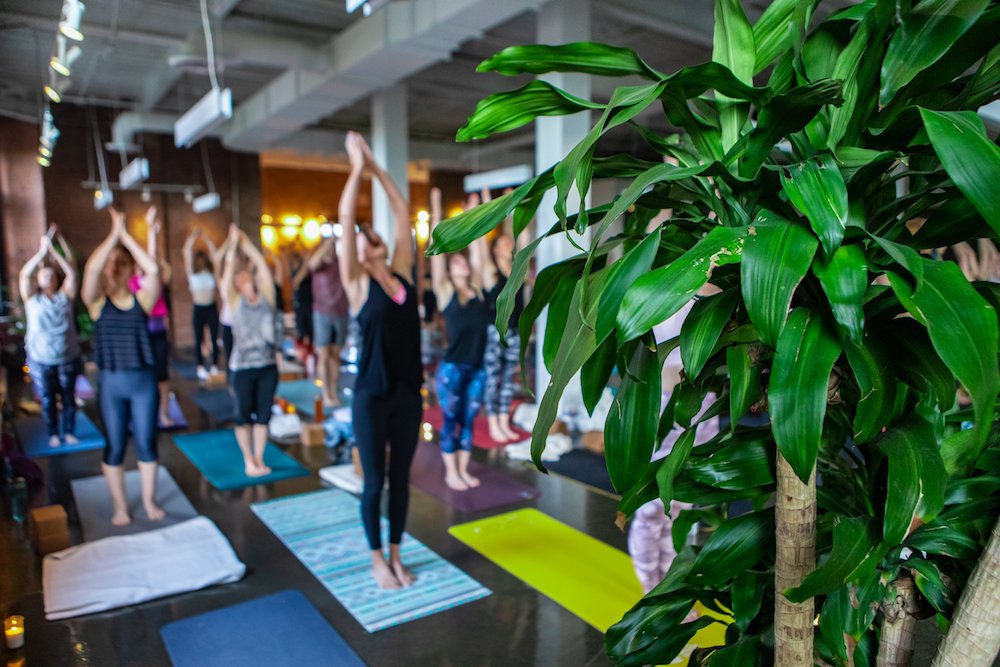Sun Salutations are such a key piece of a yoga asana practice and yet, we often don’t take the time to really think about what’s happening physiologically with the body in each pose and how that relates to and supports the breath. Yoga & Anatomy course instructor at YogaRenew Online Teacher Training, Joe Miller shared 4 common misconceptions that students make about sun salutations and provided tips for each.
Misconception #1 – Hips-width apart in Tadasana means outside of the hips
I think one common misconception that students have when they hear the idea that we are standing with the feet hips-width apart in tadasana, is to think that means “outsides of the hips”. But in fact, when we talk about hips width in asana, what we’re really talking about is the distance between the hip joints.
Tip: Place your fingers at your hip creases and bend your knees, sitting your hips back a little bit. This allows you to find the place where the fold is actually happening, where the forward bend is really happening at the hips. That’s where the hip joints are. When you stand up again and keep your fingers where the hip joints are, you can see they’re actually several inches farther in from the side of the hips. So when you’re standing with her feet hips-width apart, we want to draw a vertical line from the hip joints down through the heels and into the ground.
Misconception #2 – Flat back means making your back parallel to the floor
I think sometimes students have a misunderstanding of what flat back means. Flat back does not mean making your back “flat” or “parallel to the floor”. What we’re really doing is we’re keeping the hips flexed and lengthening your chest away from the pelvis.
Tip: Start in a forward fold and place a block on your sacrum, or the back of your pelvis. The block will be at an angle. Extend your spine, but keep your pelvis as is, with your hips flexed and inhale to lengthen your chest away from your pelvis.
Misconception #3 – Wrists shouldn’t bend past 90 degrees in upward facing dog
I sometimes find students have trouble coming into upward facing dog from chaturanga. They kind of push forward over their toes and wind up in a position where the shoulders are out in front of the wrist. Wrists are strong, resilient joints, and can bend past 90 degrees, but some students may find that the more that they bend the wrist past 90 degrees, the more that they’re feeling a little bit of sense of stress on the wrist.
Tip: If that’s the case, what I usually suggest to those students is as they come forward into plank and they lower to chaturanga, they step over their toes and bring the toes back a little bit. Your shoulders will land on top of your wrists, so it’s less of an extreme angle at the wrists. A more anatomical distinction about that position of the wrists is that you might think your wrists are flexed, but technically, your wrists are actually extended in this position.
Misconception #4 – Downward facing dog means heels down to the ground
I think sometimes students have an idea that in downward facing dog, they must get the heels down to the ground. And that’s because we get the instruction to “press the heels toward the floor”. Now, I’m not saying that’s not part of the pose. We are, in fact, trying to lengthen the heels down and lengthen the sitting bones up, but they do not need to touch the ground.
Tip: Instead of walking your feet up a little bit to get your heels on the ground, which in turn, may lead to rounding in the back, walk your feet back a little bit, even if your heels are not on the ground to fully lengthen your spine.
Interested in learning more? Get your free Anatomy of Sun Salutations’ Guide HERE and check out the full ‘Anatomy of Sun Salutations’ video for free on YogaRene’ws YouTube channel here: https://www.youtube.com/watch?v=cEpXzCgDh5U
The Editorial Team at Lake Oconee Health is made up of skilled health and wellness writers and experts, led by Daniel Casciato who has over 25 years of experience in healthcare writing. Since 1998, we have produced compelling and informative content for numerous publications, establishing ourselves as a trusted resource for health and wellness information. We aim to provide our readers with valuable insights and guidance to help them lead healthier and happier lives.
































